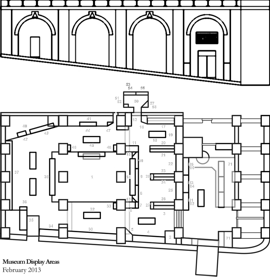Category:Japanese Dolls (display): Difference between revisions
(text) |
(spacing) |
||
| Line 4: | Line 4: | ||
Called ''Ningyō'', meaning ‘of human shape’, Japanese dolls have been crafted and used in Japanese culture for thousands of years. The first dolls can be dated back to almost 8000 BC/BCE, however, the height of doll-making is known to have occurred between 1603 and 1867 during the Edo period when Japanese trade relations were minimal due to a reduction in trade relations, meaning that domestically-produced luxury goods were rigorously perfected. | Called ''Ningyō'', meaning ‘of human shape’, Japanese dolls have been crafted and used in Japanese culture for thousands of years. The first dolls can be dated back to almost 8000 BC/BCE, however, the height of doll-making is known to have occurred between 1603 and 1867 during the Edo period when Japanese trade relations were minimal due to a reduction in trade relations, meaning that domestically-produced luxury goods were rigorously perfected. | ||
Dolls have been profoundly bound-up in Japanese life, their uses ranging from simply toys and good luck charms to children, to powerful protective charms, ceremonial and religious icons, or representations of life events or the imperial court, and even as wedding gifts and honoured diplomatic gifts for political purposes. Bound up in the Japanese pagan religion, Shinto, dolls were believed to hold great spiritual power, due to their close likeness of the human form. Notoriously, dolls have been used for ''Hinamatsuri'', (Girls’ Day, March 3rd) and ''Kodomo no Hi'', (Children’s Day, May 5th, derived from ''Tango no Sekku'', Boy’s Day). | Dolls have been profoundly bound-up in Japanese life, their uses ranging from simply toys and good luck charms to children, to powerful protective charms, ceremonial and religious icons, or representations of life events or the imperial court, and even as wedding gifts and honoured diplomatic gifts for political purposes. Bound up in the Japanese pagan religion, Shinto, dolls were believed to hold great spiritual power, due to their close likeness of the human form. Notoriously, dolls have been used for ''Hinamatsuri'', (Girls’ Day, March 3rd) and ''Kodomo no Hi'', (Children’s Day, May 5th, derived from ''Tango no Sekku'', Boy’s Day). | ||
'''Our collection''' | '''Our collection''' | ||
| Line 11: | Line 13: | ||
The oldest dolls include one of our Ichimatsu dolls, and some of our dolls resembling the Emperor and Empress of the imperial court (classified under 'Hina Dolls'). | The oldest dolls include one of our Ichimatsu dolls, and some of our dolls resembling the Emperor and Empress of the imperial court (classified under 'Hina Dolls'). | ||
Our later dolls include the Nishi Geisha Dolls, probably produced between the 1950s and 1970s. | Our later dolls include the Nishi Geisha Dolls, probably produced between the 1950s and 1970s. | ||
However, the main feature of our collection is undoubtedly the Complete Hina Doll collection around the cabinet. Hina Dolls were displayed during Girl's Day and were displayed on a tiered platform to resemble the hierarchy of the imperial household. Most Hina Dolls displays have three tiers displaying the Emperor and Empress, Court Ladies and Musicians. However, ours at the museum displays those mentioned, but goes on to include Court Ministers, and the often forgotten Shicho Servants. | However, the main feature of our collection is undoubtedly the Complete Hina Doll collection around the cabinet. Hina Dolls were displayed during Girl's Day and were displayed on a tiered platform to resemble the hierarchy of the imperial household. Most Hina Dolls displays have three tiers displaying the Emperor and Empress, Court Ladies and Musicians. However, ours at the museum displays those mentioned, but goes on to include Court Ministers, and the often forgotten Shicho Servants. | ||
Revision as of 13:52, 22 June 2013
| Display Area |
|---|
 |
| 19 - Antique and Vintage Dollhouse Miniatures (display) Arch Two |
| –– 01 02 03 04 05 06 07 08 09
10 11 12 13 14 15 16 17 18 19 20 21 22 23 24 25 26 27 28 29 30 31 32 33 34 35 36 37 38 39 40 41 42 43 44 45 46 47 48 49 50 51 52 53 54 55 –– 57 58 –– –– 61 62 63 64 65 66 67 –– –– –– 71 72 73 74 –– 76 77 78 79 80 81 82 83 84 85 86 –– –– –– |
A wall display cabinet of Japanese traditional dolls, near Puppet Corner, in Arch Two is an interesting contrast to the more Western toys in the Museum.
Called Ningyō, meaning ‘of human shape’, Japanese dolls have been crafted and used in Japanese culture for thousands of years. The first dolls can be dated back to almost 8000 BC/BCE, however, the height of doll-making is known to have occurred between 1603 and 1867 during the Edo period when Japanese trade relations were minimal due to a reduction in trade relations, meaning that domestically-produced luxury goods were rigorously perfected.
Dolls have been profoundly bound-up in Japanese life, their uses ranging from simply toys and good luck charms to children, to powerful protective charms, ceremonial and religious icons, or representations of life events or the imperial court, and even as wedding gifts and honoured diplomatic gifts for political purposes. Bound up in the Japanese pagan religion, Shinto, dolls were believed to hold great spiritual power, due to their close likeness of the human form. Notoriously, dolls have been used for Hinamatsuri, (Girls’ Day, March 3rd) and Kodomo no Hi, (Children’s Day, May 5th, derived from Tango no Sekku, Boy’s Day).
Our collection
Our collection here at the museum consists of dolls dated between the late 1800s, all the way through to the 1970s.
The oldest dolls include one of our Ichimatsu dolls, and some of our dolls resembling the Emperor and Empress of the imperial court (classified under 'Hina Dolls').
Our later dolls include the Nishi Geisha Dolls, probably produced between the 1950s and 1970s.
However, the main feature of our collection is undoubtedly the Complete Hina Doll collection around the cabinet. Hina Dolls were displayed during Girl's Day and were displayed on a tiered platform to resemble the hierarchy of the imperial household. Most Hina Dolls displays have three tiers displaying the Emperor and Empress, Court Ladies and Musicians. However, ours at the museum displays those mentioned, but goes on to include Court Ministers, and the often forgotten Shicho Servants.
Pages in category ‘Japanese Dolls (display)’
The following 6 pages are in this category, out of 6 total.
Media in category ‘Japanese Dolls (display)’
The following 11 files are in this category, out of 11 total.
- Baby Ichimatsu Dolls (Japanese Dolls).jpg 2,200 × 1,469; 1.01 MB
- Dancing Nishi Dolls (Japanese Dolls).jpg 800 × 1,200; 561 KB
- Dancing Nishi Dolls, faces (Japanese Dolls).jpg 2,000 × 1,336; 918 KB
- Japanese Dolls detail.jpg 800 × 798; 442 KB
- Japanese Dolls display, 2013 redisplay.jpg 1,024 × 1,050; 311 KB
- Large Geisha Doll (Japanese Dolls).jpg 1,200 × 1,800; 1,024 KB
- Man pulling woman passenger in handcart (Japanese Dolls).jpg 1,200 × 801; 243 KB
- Nishi Dolls man and woman (Japanese Dolls).jpg 1,200 × 801; 206 KB
- Nishi Geisha Doll upper (Japanese Dolls).jpg 2,000 × 1,336; 1.11 MB
- Samurai Dolls (Japanese Dolls).jpg 1,800 × 1,202; 1.05 MB
- Warrior Doll (Japanese Dolls).jpg 1,600 × 1,598; 968 KB














